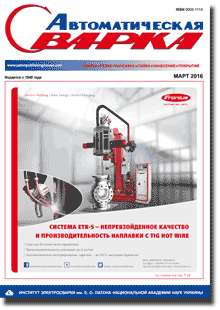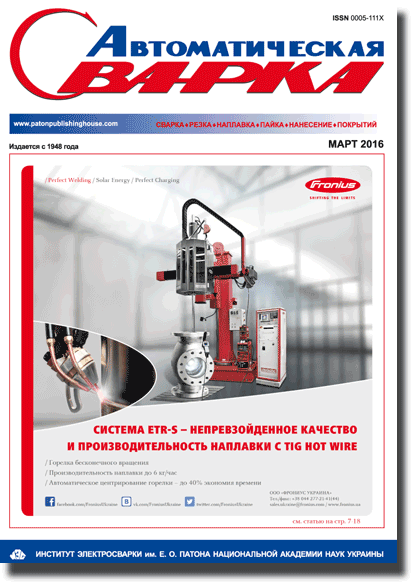Доступ для скачивания ПДФ файлов журналов для подписчиков и рецензентов наукометрических баз.
Организация: Elsevier for content accessПДФ файлы журналов изданных ранее 2024 года открыты для загрузки)
Организация: Elsevier for content accessПДФ файлы журналов изданных ранее 2024 года открыты для загрузки)
| 2016 №03 (08) |
DOI of Article 10.15407/as2016.03.01 |
2016 №03 (02) |

Журнал «Автоматическая сварка», № 3, 2016, с. 7-18
Современное состояние и применение технологии дуговой сварки (наплавки) вольфрамовым электродом в защитных газах
Ш. Эгерланд, Й. Циммер, Р. Брунмайер, Р. Нуссбаумер, Г. Пош, Б. Рутцингер
Fronius International GmbH, Wels, Austria. E-mail:egerland.stephan@fronius.comРеферат
Дуговая сварка вольфрамовым электродом в среде защитных газов (GTAW) — процесс, который известен тем, что он обеспечивает наивысшее качество сварки, хотя и имеет более низкие характеристики производительности. К дуговой сварке в защитных газах (GMAW) часто прибегают с целью повышения производительности с обеспечением качества, соответствующего общепринятым стандартам. В секторах промышленности, где требуется выполнение высококачественной, например, коррозионностойкой наплавки с применением присадочных материалов на никелевой основе, жестко соблюдается необходимость удовлетворения критерия «нулевого дефекта». В этой связи ограниченная производительность преодолевается использованием передовых систем GTAW с «горячей» проволокой. В настоящей статье, с позиций автоматизации сварки, описывается состояние технологий в этой области включая устройства и их применения, а именно процесс сварки (наплавки) GTAW со сдвоенным катодом и «горячей» проволокой, что значительно расширяет достигаемые пределы производительности. Библиогр. 27, табл. 2, рис. 14.
Ключевые слова: сварка (наплавка) GTAW, одиночный катод, сдвоенный катод, «горячая проволока», производительность сварки, нулевая дефектность, разбавление металла
Поступила в редакцию 15.01.2016
Подписано в печать 02.03.2016
- Egerland S. Control led GMA welding processes prove applicability for high-quality weld overlay. In: Proceedings of the welding and repair technology for power plants: 9th international EPRI Conference; 2010 June 23-25; Fort Myers. Palo Alto: Electric Power Research Institute, 2010.
- Egerland S. Status and perspectives in overlaying under particular consideration of sophisticated welding processes. Quarterly Journal of the Japan Welding Society. – 2009, –27(2), P. 50–54.
- Egerland S., Helmholdt R. Overlaying (cladding) of high temperature affected components by using the cold metaltransfer process. In: Mayr P., Editor. Safety and Reliability of Welded Components in Energy and Processing Industry. Austria: Verlag der Technischen Universitat Graz, 2008. P. 327–332.
- Freeman N.D., Manz A.F., Saenger JF.Jr., Stanchus F.T., inventors; Union Carbide Corp, assign. Method for depositing metal with a TIG arc. United States patent US 3483354.1969 Dec 9.
- Manz A.F., Norman R., Wroth R.S., inventors; Union Carbide Corp, assign. Electric arc working with hot wire addition. United States patent US 3163743.1964 Dec 29.
- Manz A.F., inventors; Union Carbide Corp, assign. Consumable electrode arcless electric working. United States patent US 3122629A. 1964 Feb 25.
- Hori K., Myoga T., Shinomiya M., Eiji W., Kazuki K., Toshiaki T. et al., inventors; Kaisha BHK, assign. Semi-automatic hot wire TIG welding equipment. United States patent US 4801781. 1989 Jan 31.
- Mizuno T., Shimizu T., inventors; Kaisha MDK, assign. Hot wire welding system. United States patent US 4464558A. 1984 Aug 7.
- Goldsberry C. Hot-wire TIG: not new but gaining appeal [web page], [access in 3 oct. 2015]. Cleveland: Welding Design & Fabrication; 2007. Available from: http://weldingdesign. com/archive/hot-wiretig-not-new-gaining-appeal.
- Manabe Y., Wada H., Zenitani S., HiromoloY., HashimotoY. Investigation on TIG welding using 2 filler wires with electromagnetically controlled molten pool process in horizontal position. Quarterly Journal of the Japan Welding Society. 2000. –18(l). – P. 40–50. http://dx.doi.org/10.2207/qjjws.18.40.
- Hori K., Watanabe H., Myoga T., Kusano K. Development of hot wire TIG welding methods using pulsed current to heat filler wire: research on pulse heated hot wire TIG welding processes. Welding International. – 2004, 18(6). – P. 456–468. ttp://dx.doi.org/10.1533/wint.2004.3281.
- Ueguri S., Tabata Y., Shimizu T., MizunoT. A study on control of deposition rate in hot-wire TIG welding. Quarterly Journal of the Japan Welding Society. – 1986. – 4(4). – P. 678–684. http://dx.doi.org/10.2207/qjjws.4.678.
- Yamamoto M., Shinozaki K., Myoga T., Kanazawa T., Arashin H. Development of ultra-high-speed GTA welding process using pulse-heated hot-wire. In: Pre-Prints of the 82nd National Meeting of JWS, Tokyo: Japan Welding Society, 2008. – P. 228–229.
- Shinozaki K.,Yamamoto M., Nagamitsu Y., Uchida T., Mitsuhata K., Nagashima T. et al. Melting phenomenon during ultra-high-speed GTA welding method using pulse-heated hotwire. Quarterly Journal of the Japan Welding Society. 2009. – 27(2). – P. 22–26. http:/dx.doi.org/10.2207/qjjws.27.22s.
- Adonyi Y., Richardson R., Baeslack W. Investigation of arc force effects in subsurface GTA welding. Welding Journal. – 1992. – 71(9). – P. 321–330.
- Rokhlin S., Guu A. A study of arc force, pool depression, and weld penetration during gas tungsten arc welding. Welding Journal. – 1993. – 72(8). – P. 381–390.
- Mendez P., EagarT. Penetration and defect formation in high-current arc welding. Welding Journal. – 2003. – 82(10). – P. 296–306.
- Yamada M. Development of high efficiency TIG welding method. 1st Report of the Japan Welding Society. – 1998. – 63. – P. 24–25.
- Yamada M., Tejima A., inventors; Ishikawajima-Harima Heavy Industries Co., assign. TIG welding apparatus and method. United States patent US 6982397. 2006 Jan 3.
- Kobayasrv K., NishimuraY., IijimaT., Ushio М., Tаnака M., Shimamura J., et al. Practical application of high efficiency twinarc TIG welding method (SEDAR-TIG) for PCLNG storage tank. Welding in the World. 2013. – 48(7-8). P. 35–39.
- Norrish J. Advanced welding processes. Cambridge: Woodhead Publishing, 2006.
- Zhang G., Leng X., Lin W. Physics characteristic of coupling arc of twin-tungsten TIG welding. Transactions of Nonferrous Metals Society of China. – 2006. –16(4). – P. 813–817.
- Leng X., Znang G., Wu L. The characteristic of twin-electrode TIG coupling arc pressure. Journal of Physics D, Applied Physics. – 2006. – 39(6). – P. 1120–1126. http://dx.doiorg/10.1088/0022-3727/39/6/017.
- Maecker H. Plasmastromungen in Lichtbogen infolge eigenmagnetischer Kompression. Zeitschrift fur Physik. – 1955. – 141(1). – P. 198–216.
- Zhang G., Xiong J., Gao H., Wu L. Effect of process parameters on temperature distribution in twin-electrode TIG coupling arc. – Journal of Quantitative Spectroscopy & Radiative Transfer. 2012. – 113(15). – P. 1938–1945. http://dx.doi.org/10.1016/jqsrt.2012.05.018.
- Martins А. Avaliacaoda soldagem tig autogena duplo catodo twin Tig [trabal ho de graduacao], Fionanopolis: Universidade Federal de Santa Catarina; 2010.
- Special Metal Corporation. Inconel alloy 625. Special metals. 2006. – Material Manufacturer Data Sheet.
Вартість передплати/замовлення на журнали або окремі статті
| журнал/валюта | річний комплект друкований |
1 прим. друкований |
1 прим. електронний |
одна стаття (pdf) |
| AS/UAH | 1800 грн. | 300 грн. | 300 грн. | 150 грн. |
| AS/USD | 192 $ | 32 $ | 26 $ | 13 $ |
| AS/EUR | 180 € | 30 € | 25 € | 12 € |
| TPWJ/UAH | 7200 грн. | 600 грн. | 600 грн. | 280 грн. |
| TPWJ/USD | 384 $ | 32 $ | 26 $ | 13 $ |
| TPWJ/EUR | 348 € | 29 € | 24 € | 12 € |
| SEM/UAH | 1200 грн. | 300 грн. | 300 грн. | 150 грн. |
| SEM/USD | 128 $ | 32 $ | 26 $ | 13 $ |
| SEM/EUR | 120 € | 30 € | 25 € | 12 € |
| TDNK/UAH | 1200 грн. | 300 грн. | 300 грн. | 150 грн. |
| TDNK/USD | 128 $ | 32 $ | 26 $ | 13 $ |
| TDNK/EUR | 120 € | 30 € | 25 € | 12 € |
AS = «Автоматическая сварка» - 6 накладів на рік;
TPWJ = «PATON WELDING JOURNAL» - 12 накладів на рік;
SEM = «Современная электрометаллургия» - 4 наклада на рік;
TDNK = «Техническая диагностика и неразрушающий контроль» - 4 наклада на рік.





